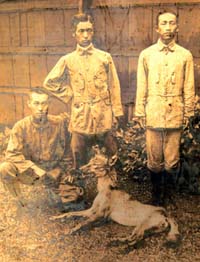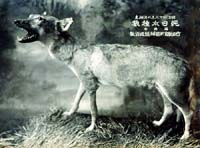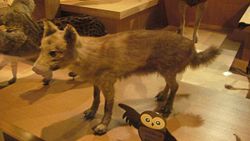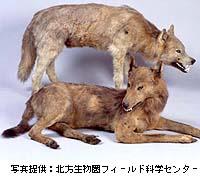
October 24, 2008
In a world of increasing documentary treatments of international cryptids, one hidden animal that I feel should be highlighted more is the Honshū Wolf of Japan.
Let’s revisit this Mystery Canid.

An update worth mentioning is that I was able to finally find a small replica of the Honshū Wolf of Japan (shown above). I actually obtained two figurines, so I could send one back to Japan in thanks to researcher Brent Swancer. He had not been able to track one down yet, so since he had generously shared his translations on the cryptid below, it seemed only right he should have a figurine of the cryptic wolf.



The world’s smallest variety of wolf, the Japanese wolf, also called the Honshū Wolf (Canis lupus hodophilax), supposedly became extinct in 1905 in Nara prefecture, Japan. But did some survive beyond that date? And was there physical proof of this event, in 1910, in Fukui prefecture?
Sightings of the Japanese wolf persist to the present, and yet, even the date of the “last one” is in dispute. A new debate is occurring currently in Japan that the extinction date may have been incorrect, almost immediately.
Intriguingly, finding a taxidermy example of the Honshū Wolf presently is quite difficult. Only five mounted specimens are said to be known worldwide: three in Japan, one in the Netherlands (which is pictured in the beautiful book, Swift as a Swallow), and the supposedly final 1905 animal, which is located at the British Natural History Museum.
But was there another taxidermy mount that proved these wolves lived beyond 1905?
In Japan, a 2007 Asahi News discussion surfaced regarding the photographs you see here. I am grateful to cryptozoology historian American Brent Swancer (who lives in Japan) for passing along to me information and his translation.
Supposedly killed in 1910 in Fukui, the Japanese wolf in the first of the three above photographs is apparently genuine. The article explains that the last officially known Japanese wolf died in 1905, yet here is one that was allegedly killed five years later, in 1910.
Unfortunately, the body was destroyed in a fire, according to the article. The picture in the middle is a taxidermy-mounted specimen of that last known Japanese wolf and the photo at the bottom is the farm where the wolf was shot in 1910.
The two photos of the dead animal today remain as the only real evidence that this wolf existed since the body has long since been destroyed.
In the Asahi News article there is a mention that in an issue of the Fukui agricultural magazine of the time, zoo staff had examined the animal the day after the shooting in 1910. They came to the conclusion that it was indeed a Japanese wolf. Unfortunately, it seems that that is as far as the examination went. It appears that those who advocate that this was a Japanese wolf point to that Fukui magazine article, as well as comparing the morphology of the animal pictured to data on the Japanese wolf. But it is inconclusive and not enough to change the common historical record that the last known specimen died in Nara in 1905. Brent Swancer

The mounted Honshū Wolf (Canis lupus hodophilax) in the National Science Museum of Japan.

The closely related elusive Hokkaido Wolf (Canis lupus hattai).
About Loren Coleman
Loren Coleman is one of the world’s leading cryptozoologists, some say “the” leading living cryptozoologist. Certainly, he is acknowledged as the current living American researcher and writer who has most popularized cryptozoology in the late 20th and early 21st centuries.
Starting his fieldwork and investigations in 1960, after traveling and trekking extensively in pursuit of cryptozoological mysteries, Coleman began writing to share his experiences in 1969. An honorary member of Ivan T. Sanderson’s Society for the Investigation of the Unexplained in the 1970s, Coleman has been bestowed with similar honorary memberships of the North Idaho College Cryptozoology Club in 1983, and in subsequent years, that of the British Columbia Scientific Cryptozoology Club, CryptoSafari International, and other international organizations. He was also a Life Member and Benefactor of the International Society of Cryptozoology (now-defunct).
Loren Coleman’s daily blog, as a member of the Cryptomundo Team, served as an ongoing avenue of communication for the ever-growing body of cryptozoo news from 2005 through 2013. He returned as an infrequent contributor beginning Halloween week of 2015.
Coleman is the founder in 2003, and current director of the International Cryptozoology Museum in Portland, Maine.
Filed under Cryptid Canids, Cryptomundo Exclusive, Cryptotourism, CryptoZoo News, Cryptozoologists, Cryptozoology, Evidence, Eyewitness Accounts, Folklore, Museums, Replica Cryptia